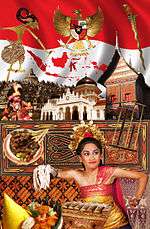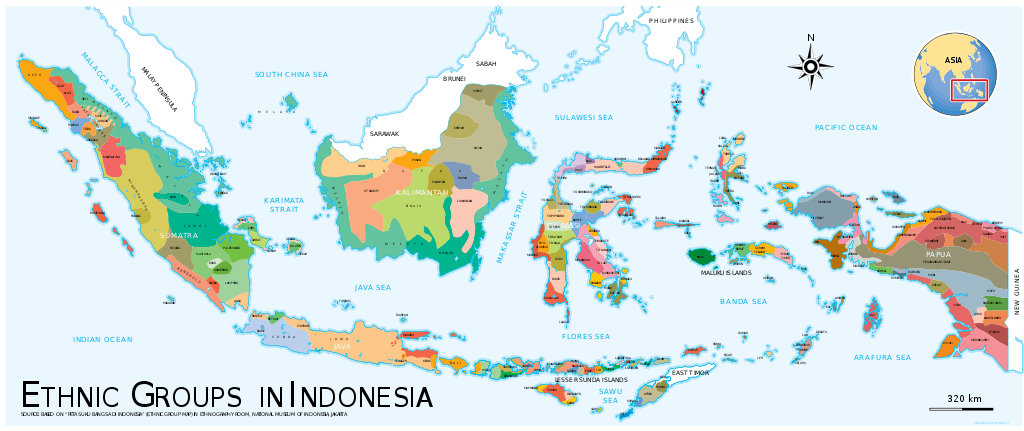Ethnic groups in Indonesia
| Part of a series on the |
| Culture of Indonesia |
|---|
 |
| History |
| People |
| Languages |
| Cuisine |
| Literature |
|
Music and performing arts |
| Sport |
|
Monuments |
|
There are over 300 ethnic groups in Indonesia including Javanese, Sundanese, and Batak.
Based on ethnic group, the largest ethnic group in Indonesia is the Javanese who make up about 40% of the total population. The Javanese are concentrated on the island of Java but millions have migrated to other islands throughout the archipelago because of the transmigration program.[1] The Sundanese, Malay, and Madurese are the next largest groups in the country.[1] Many ethnic groups, particularly in Kalimantan and Papua, have only hundreds of members. Most of the local languages belong to Austronesian language family, although a significant number, particularly in Papua, speak Papuan languages. Chinese Indonesians population makes up a little less than 1% of the total Indonesian population according to the 2000 census.[1] Some of these Indonesians of Chinese descent speak various Chinese dialects, most notably Hokkien and Hakka.
The classification of ethnic groups in Indonesia is not rigid and in some cases unclear due to migrations, cultural and linguistic influences; for example some may consider Bantenese and Cirebonese to be members of the Javanese people; however, some others argue that they are different ethnic groups altogether since they have their own distinct dialects. This is the same case with Baduy people that share many cultural similarities with the Sundanese people. An example of hybrid ethnicity is the Betawi people, descended not only from marriages between different peoples in Indonesia but also with Arab, Chinese and Indian migrants since the era of colonial Batavia (Jakarta).
Numbers
2010
Number and percentage of population of ethnic groups according to a 2010 census.[2]
The proportions of Indonesian ethnic groups according to the (2000 census) are as follows:[3]

Indigenous ethnicities
The regions of Indonesia have some of their indigenous ethnic groups. Due to migration within Indonesia (as part of government transmigration programs or otherwise), there are significant populations of ethnic groups who reside outside of their traditional regions.
- Java: Javanese (Tenggerese, Osing, Banyumasan, etc.), Sundanese (Bantenese, Badui), Betawi
- Madura: Madurese
- Sumatra: Malays, Batak, Minangkabau, Acehnese, Lampung, Kubu
- Kalimantan: Dayak, Banjar, Malays
- Sulawesi: Makassarese, Buginese, Mandarese, Minahasan, Toraja, Bajauan
- Lesser Sunda Islands: Balinese, Sasaki, Sumbawan, Dawan, Tetunian, Helong, Roti, Savu, Sumban, Alorese, Floresian
- The Moluccas: Alfur, Nuaulu, Manusela, Wemale, Tanimbarese
- Papua: Dani, Bauzi, Asmat, Amungme
Foreign ethnicities
Throughout Indonesian history, waves of migration of foreign origin ethnicities were spread throughout Indonesia, usually inhabiting urban centres and seldom reaching rural parts of Indonesia.
- Chinese: The most significant ethnic minority of foreign origin in Indonesia. Chinese began inhabiting Indonesia since the 15th century with significant waves in 18th and 19th century. Mostly concentrated in pecinan (chinatowns) in urban Java, Sumatra and Kalimantan cities with significant numbers in Jakarta, North Sumatra, Riau, Riau Islands, Bangka-Belitung Islands, and West Kalimantan.
- Arabs: Historically Arab traders were responsible for the spread of Islam in the Indonesian archipelago. Many have assimilated into local ethnicities such as Betawi, Malay, Javanese, and Sundanese; however, several cities in Indonesia have significant Arab populations that preserve their culture, identity, and their links to Arabic countries. Spread throughout Indonesian cities, significant numbers can be found in Medan, Banda Aceh, Padang, Jakarta, Surabaya, Gresik and many coastal cities in Indonesia.
- Indian: Indian people also had settled the Indonesian archipelago; however, their number is not as large as that of Chinese Indonesians. Concentrated in urban centres with significant numbers around Pasar Baru in Jakarta, and Kampung Keling (now Kampung Madras) in Medan.
- Indos: Indos or Eurasians, of mixed ancestry between Indonesian native ethnic groups and European/Dutch ancestry, they emerged during the Dutch East Indies period. Around one million Indonesians with various degrees of mixed ancestry today can trace their ancestry to Europeans. During the colonial period, their numbers were greater, but since Indonesian independence most chose to go to the Netherlands. Eurasian Indonesians dwindle in number as an ethnic group since major emigration from Indonesia after World War II.
- Mardijker : The name means "freeman" and derives from Dutch pronunciation of the Malay word "merdeka", meaning "free". The ancestors of the Mardijkers had been slaves of the Portuguese in India, Africa and Malay Peninsula. They were brought to Indonesia by the Dutch East India Company and freed after their settlement. Over a great length of time they would eventually be absorbed into the larger Indonesian community, though a neighborhood, Kampung Tugu, still exists today and retains its own distinct culture characteristic of the Mardijker peoples.
- Japanese: Japanese have migrated to Indonesia since the Dutch East Indies colonial era; however, after their defeat in World War II, their number decreased, leaving small numbers of ex-Japanese soldiers that still stayed in Indonesia and became Indonesian citizens. The recent development of Japanese residents in Indonesia was driven by the increase of Japanese business and investment in Indonesia since the 1970s, and mostly are expatriates that still maintain their Japanese citizenship. Significant numbers of Japanese expatriates stay in Indonesia, especially in Jakarta and Bali.
- Korean: They are a recent addition of Indonesian foreign origin ethnicities, dated back only several decades ago. Mostly driven by the increase of Korean business and investment in Indonesia, and most are expatriates that still maintain their Korean citizenship.
See also
References
- 1 2 3 Indonesia's Population: Ethnicity and Religion in a Changing Political Landscape. Institute of Southeast Asian Studies. 2023. Check date values in:
|year=(help) - ↑ http://www.bps.go.id/website/pdf_publikasi/watermark%20_Kewarganegaraan,%20Suku%20Bangsa,%20Agama%20dan%20Bahasa_281211.pdf
- ↑ Leo Suryadinata, Evi Nurvidya Arifin, Aris Ananta; Indonesia's Population: Ethnicity and Religion in a Changing Political Landscape, 2003
